warning light KIA K900 2017 Features and Functions Guide
[x] Cancel search | Manufacturer: KIA, Model Year: 2017, Model line: K900, Model: KIA K900 2017Pages: 62, PDF Size: 6.38 MB
Page 3 of 62
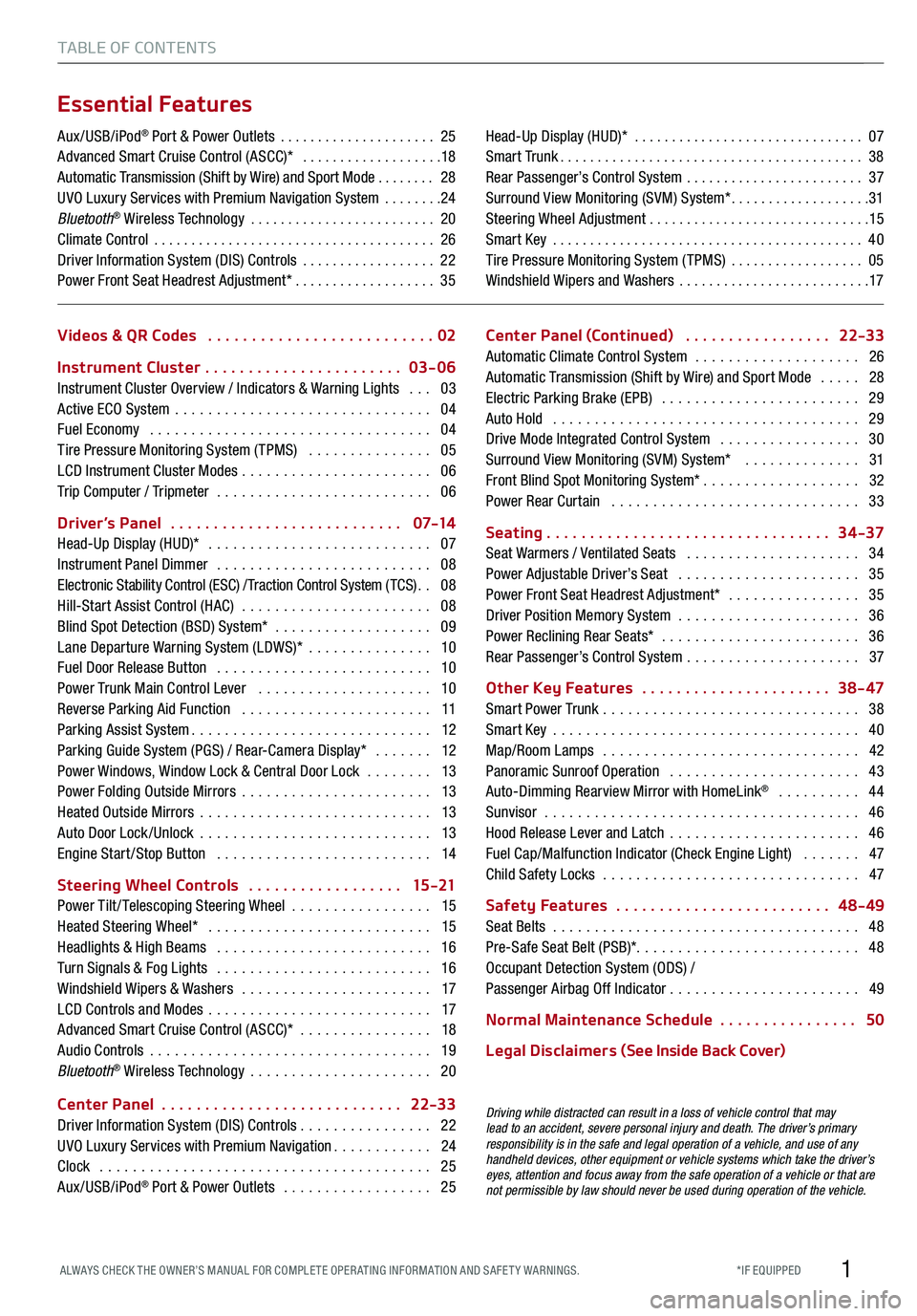
1
TABLE OF CONTENTS
Videos & QR Codes ..........................02
Instrument Cluster
.......................03-06
Instrument Cluster Overview / Indicators & Warning Lights ...03
Active ECO System ...............................04
Fuel Economy ..................................04
Tire Pressure Monitoring System (TPMS) ...............05
LCD Instrument Cluster Modes .......................06
Trip Computer / Tripmeter ..........................06
Driver’s Panel
...........................0 7-14
Head-Up Display (HUD)* ...........................07
Instrument Panel Dimmer ..........................08
Electronic Stability Control (ESC) / Traction Control System ( TCS) ..08
Hill-Start Assist Control (HAC) .......................08
Blind Spot Detection (BSD) System* ...................09
Lane Departure Warning System (LDWS)* ...............10
Fuel Door Release Button ..........................10
Power Trunk Main Control Lever .....................10
Reverse Parking Aid Function .......................11
Parking Assist System .............................12
Parking Guide System (PGS) / Rear-Camera Display* .......12
Power Windows, Window Lock & Central Door Lock ........13
Power Folding Outside Mirrors .......................13
Heated Outside Mirrors ............................13
Auto Door Lock /Unlock ............................13
Engine Start /Stop Button ..........................14
Steering Wheel Controls
..................15 -21
Power Tilt/ Telescoping Steering Wheel .................15
Heated Steering Wheel* ...........................15
Headlights & High Beams ..........................16
Turn Signals & Fog Lights ..........................16
Windshield Wipers & Washers .......................17
LCD Controls and Modes ...........................17
Advanced Smart Cruise Control (ASCC)* ................18
Audio Controls ..................................19
Bluetooth® Wireless Technology ......................20
Center Panel
............................22-33
Driver Information System (DIS) Controls ................ 22
UVO Luxury Services with Premium Navigation
............24
Clock ........................................25
Aux/USB/iPod® Port & Power Outlets ..................25 Center Panel (Continued)
.................22-33
Automatic Climate Control System ....................26
Automatic Transmission (Shift by Wire) and Sport Mode .....28
Electric Parking Brake (EPB) ........................29
Auto Hold .....................................29
Drive Mode Integrated Control System .................30
Surround View Monitoring (SVM) System* ..............31
Front Blind Spot Monitoring System* ...................32
Power Rear Curtain ..............................33
Seating
.................................34-37
Seat Warmers / Ventilated Seats .....................34
Power Adjustable Driver’s Seat ......................35
Power Front Seat Headrest Adjustment* ................35
Driver Position Memory System ......................36
Power Reclining Rear Seats* ........................ 36
Rear Passenger’s Control System ..................... 37
Other Key Features
......................38 - 47
Smart Power Trunk ...............................38
Smart Key .....................................40
Map/Room Lamps ...............................42
Panoramic Sunroof Operation .......................43
Auto-Dimming Rearview Mirror with HomeLink® .......... 44
Sunvisor ......................................46
Hood Release Lever and Latch .......................46
Fuel Cap/Malfunction Indicator (Check Engine Light) .......47
Child Safety Locks ...............................47
Safety Features
.........................48-49
Seat Belts .....................................48
Pre-Safe Seat Belt (PSB)* ........................... 48
Occupant Detection System (ODS) /
Passenger Airbag Off Indicator
....................... 49
Normal Maintenance Schedule
................50
L ega l D i sc la ime r s (See Inside Back Cover)
Driving while distracted can result in a loss of vehicle control that may
lead to an accident, severe personal injury and death. The driver’s primary
responsibility is in the safe and legal operation of a vehicle, and use of any
handheld devices, other equipment or vehicle systems which take the driver’s
eyes, attention and focus away from the safe operation of a vehicle or that are
not permissible by law should never be used during operation of the vehicle.
Aux/USB/iPod® Port & Power Outlets .....................25
Advanced Smart Cruise Control (ASCC)* ...................18
Automatic Transmission (Shift by Wire) and Sport Mode ........ 28
UVO Luxury Services with Premium Navigation System ........24
Bluetooth® Wireless Technology .........................20
Climate Control ......................................26
Driver Information System (DIS) Controls ..................22
Power Front Seat Headrest Adjustment* ...................35 Head-Up Display (HUD)*
...............................07
Smart Trunk .........................................38
Rear Passenger’s Control System ........................37
Surround View Monitoring (SVM) System* ...................31
Steering Wheel Adjustment ..............................15
Smart Key ..........................................40
Tire Pressure Monitoring System (TPMS) ..................05
Windshield Wipers and Washers ..........................17
Essential Features
*IF EQUIPPED
ALWAYS CHECK THE OWNER’S MANUAL FOR COMPLE TE OPER ATING INFORMATION AND SAFE T Y WARNINGS.
Page 5 of 62
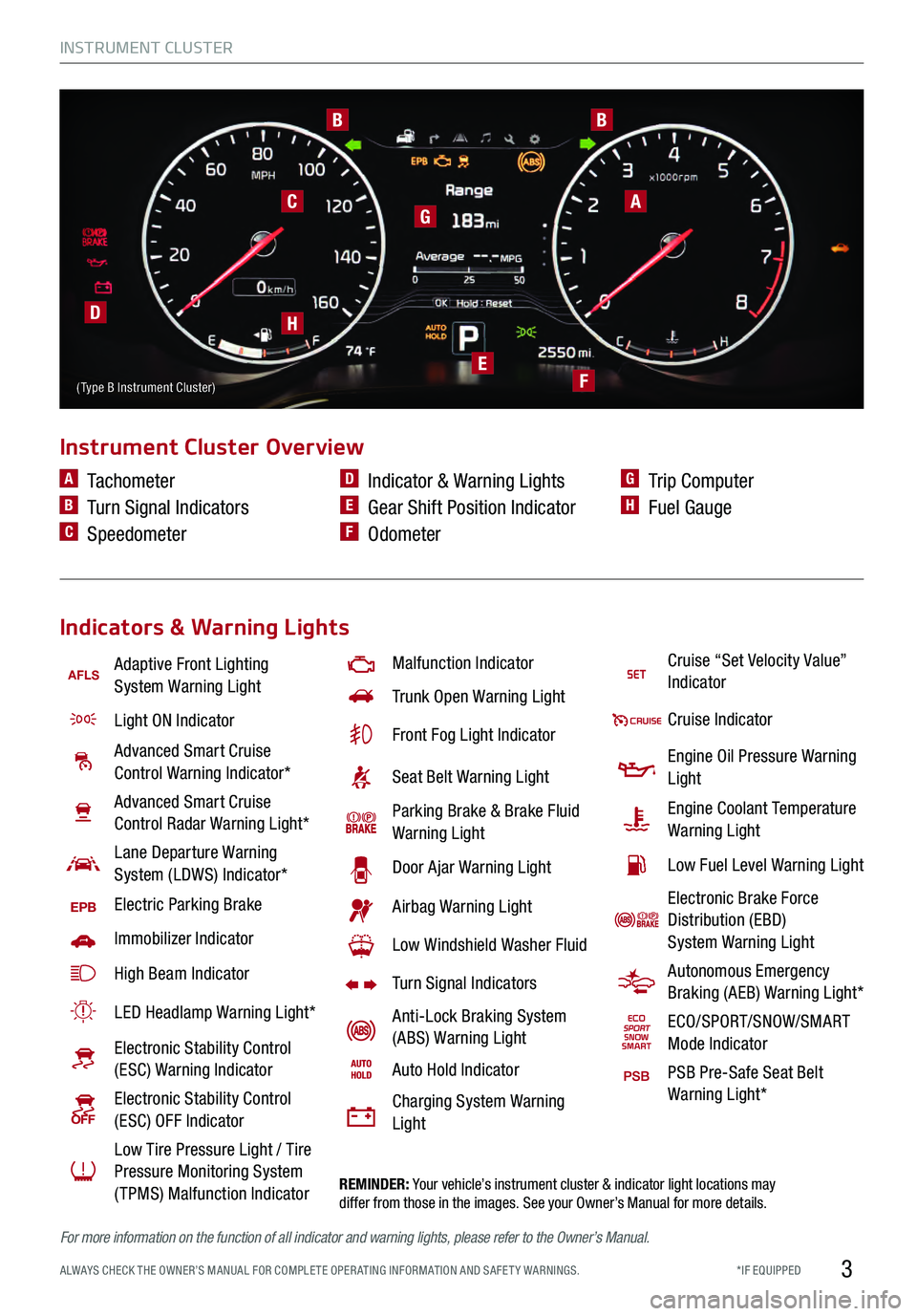
3
www.KuTechVideos.com/kh13/2017
AFLSAdaptive Front Lighting System Warning Light
Light ON Indicator
Advanced Smart Cruise Control Warning Indicator*
Advanced Smart Cruise
Control Radar Warning Light*
Lane Departure Warning
System (LDWS) Indicator*
EPBElectric Parking Brake
Immobilizer Indicator
High Beam Indicator
LED Headlamp Warning Light*
Electronic Stability Control (ESC) Warning Indicator
Electronic Stability Control (ESC) OFF Indicator
Low Tire Pressure Light / Tire
Pressure Monitoring System
(TPMS) Malfunction Indicator
Malfunction Indicator
Trunk Open Warning Light
Front Fog Light Indicator
Seat Belt Warning Light
Parking Brake & Brake Fluid Warning Light
Door Ajar Warning Light
Airbag Warning Light
Low Windshield Washer Fluid
Turn Signal Indicators
Anti-Lock Braking System
(ABS) Warning Light
Auto Hold Indicator
Charging System Warning
Light
REMINDER: Your vehicle’s instrument cluster & indicator light locations may
differ from those in the images. See your Owner’s Manual for more details.
Instrument Cluster Overview
Indicators & Warning Lights
A Tachometer
B Turn Signal Indicators
C Speedometer
D Indicator & Warning Lights
E Gear Shift Position Indicator
F Odometer
G Trip Computer
H Fuel Gauge
A
BB
C
D
E
H
G
F
Cruise “Set Velocity Value” Indicator
Cruise Indicator
Engine Oil Pressure Warning Light
Engine Coolant Temperature Warning Light
Low Fuel Level Warning Light
Electronic Brake Force Distribution (EBD)
System Warning Light
Autonomous Emergency Braking (AEB) Warning Light*
ECO/SPORT/SNOW/SMART Mode Indicator
PSB Pre-Safe Seat Belt Warning Light*
( Type B Instrument Cluster)
For more information on the function of all indicator and warning lights, please refer to the Owner’s Manual.
INSTRUMENT CLUSTER
*IF EQUIPPED
ALWAYS CHECK THE OWNER’S MANUAL FOR COMPLE TE OPER ATING INFORMATION AND SAFE T Y WARNINGS.
Page 7 of 62
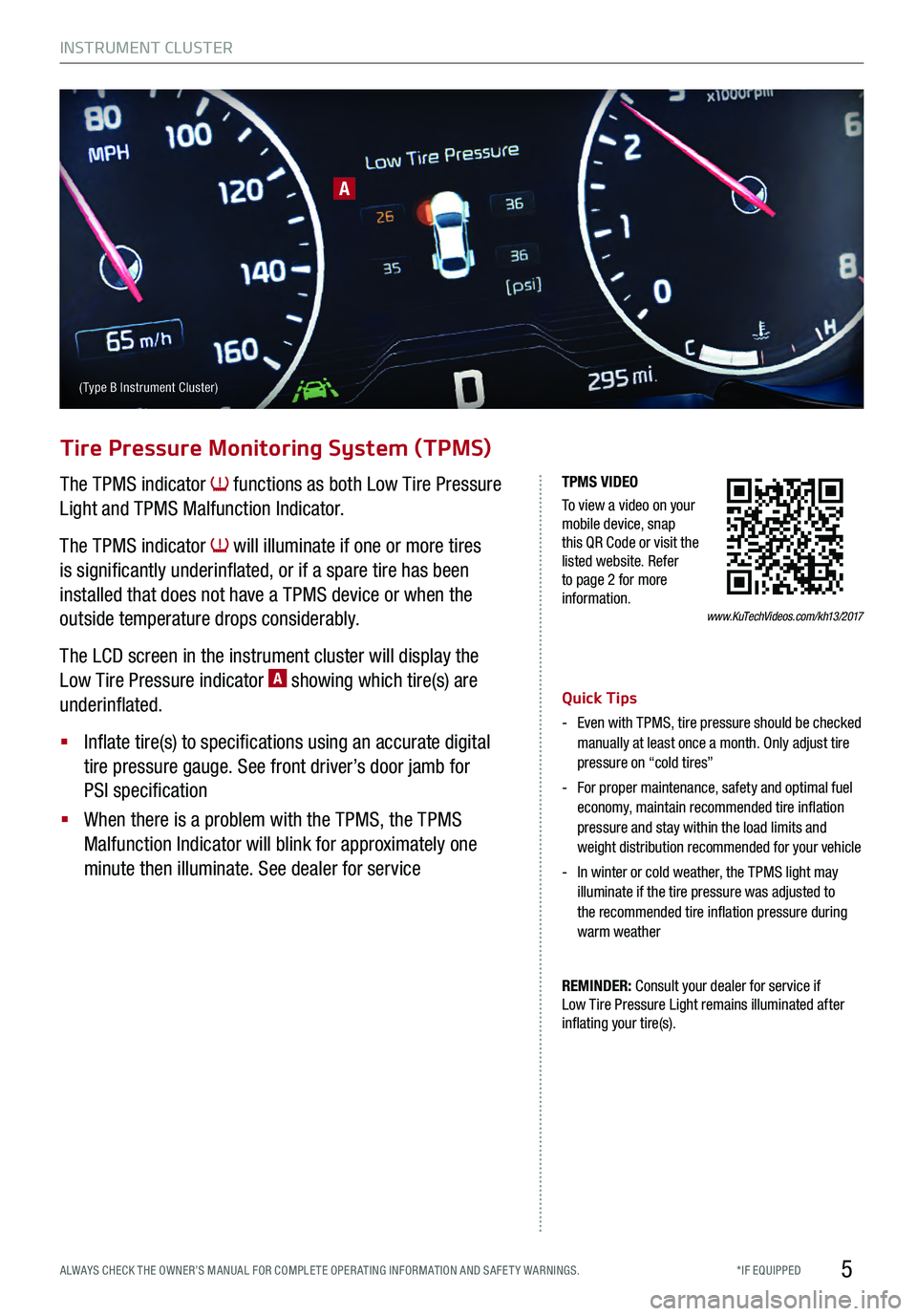
5
REMINDER: Consult your dealer for service if
Low Tire Pressure Light remains illuminated after
inflating your tire(s). Quick Tips
- Even with TPMS, tire pressure should be checked manually at least once a month. Only adjust tire
pressure on “cold tires”
- For proper maintenance, safety and optimal fuel economy, maintain recommended tire inflation
pressure and stay within the load limits and
weight distribution recommended for your vehicle
- In winter or cold weather, the TPMS light may illuminate if the tire pressure was adjusted to
the recommended tire inflation pressure during
warm weather
The TPMS indicator functions as both Low Tire Pressure
Light and TPMS Malfunction Indicator.
The TPMS indicator
will illuminate if one or more tires
is significantly underinflated, or if a spare tire has been
installed that does not have a TPMS device or when the
outside temperature drops considerably.
The LCD screen in the instrument cluster will display the
Low Tire Pressure indicator
A showing which tire(s) are
underinflated.
§
Inflate tire(s) to specifications using an accurate digital
tire pressure gauge. See front driver’s door jamb for
PSI specification
§
When there is a problem with the TPMS, the TPMS
Malfunction Indicator will blink for approximately one
minute then illuminate. See dealer for service
Tire Pressure Monitoring System (TPMS)
www.KuTechVideos.com/kh13/2017
TPMS VIDEO
To view a video on your
mobile device, snap
this QR Code or visit the
listed website. Refer
to page 2 for more
information.
A
( Type B Instrument Cluster)
INSTRUMENT CLUSTER
*IF EQUIPPED
ALWAYS CHECK THE OWNER’S MANUAL FOR COMPLE TE OPER ATING INFORMATION AND SAFE T Y WARNINGS.
Page 9 of 62
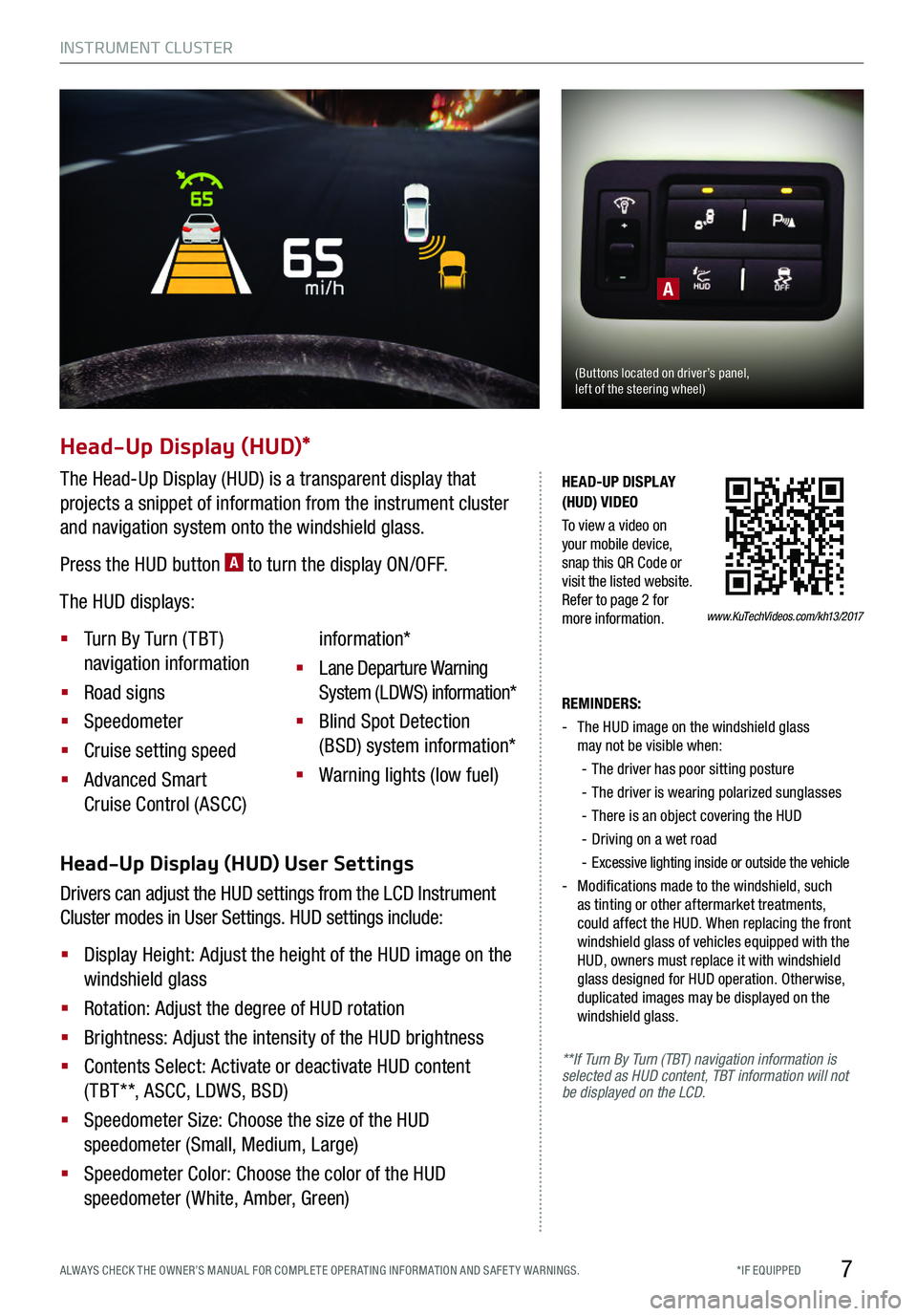
7
REMINDERS:
- The HUD image on the windshield glass
may not be visible when:
- The driver has poor sitting posture
- The driver is wearing polarized sunglasses
- There is an object covering the HUD
-Driving on a wet road
-Excessive lighting inside or outside the vehicle
- Modifications made to the windshield, such as tinting or other aftermarket treatments,
could affect the HUD. When replacing the front
windshield glass of vehicles equipped with the
HUD, owners must replace it with windshield
glass designed for HUD operation. Otherwise,
duplicated images may be displayed on the
windshield glass.
**If Turn By Turn (TBT) navigation information is
selected as HUD content, TBT information will not
be displayed on the LCD.
Head-Up Display (HUD) User Settings
Drivers can adjust the HUD settings from the LCD Instrument
Cluster modes in User Settings. HUD settings include:
§
Display Height: Adjust the height of the HUD image on the
windshield glass
§ Rotation: Adjust the degree of HUD rotation
§ Brightness: Adjust the intensity of the HUD brightness
§ Contents Select: Activate or deactivate HUD content
( TBT**, ASCC, LDWS, BSD)
§ Speedometer Size: Choose the size of the HUD
speedometer (Small, Medium, Large)
§ Speedometer Color: Choose the color of the HUD
speedometer (White, Amber, Green)
Head-Up Display (HUD)*
The Head-Up Display (HUD) is a transparent display that
projects a snippet of information from the instrument cluster
and navigation system onto the windshield glass.
Press the HUD button
A to turn the display ON/OFF.
The HUD displays:
§
Turn By Turn ( TBT )
navigation information
§
Road signs
§
Speedometer
§
Cruise setting speed
§
Advanced Smart
Cruise Control (ASCC) information*
§
Lane Departure Warning
System (LDWS) information*
§
Blind Spot Detection
(BSD) system information*
§
Warning lights (low fuel)
A
(Buttons located on driver’s panel, left of the steering wheel)
www.KuTechVideos.com/kh13/2017
HEAD-UP DISPLAY
(HUD) VIDEO
To view a video on
your mobile device,
snap this QR Code or
visit the listed website.
Refer to page 2 for
more information.
INSTRUMENT CLUSTER
*IF EQUIPPED
ALWAYS CHECK THE OWNER’S MANUAL FOR COMPLE TE OPER ATING INFORMATION AND SAFE T Y WARNINGS.
Page 11 of 62
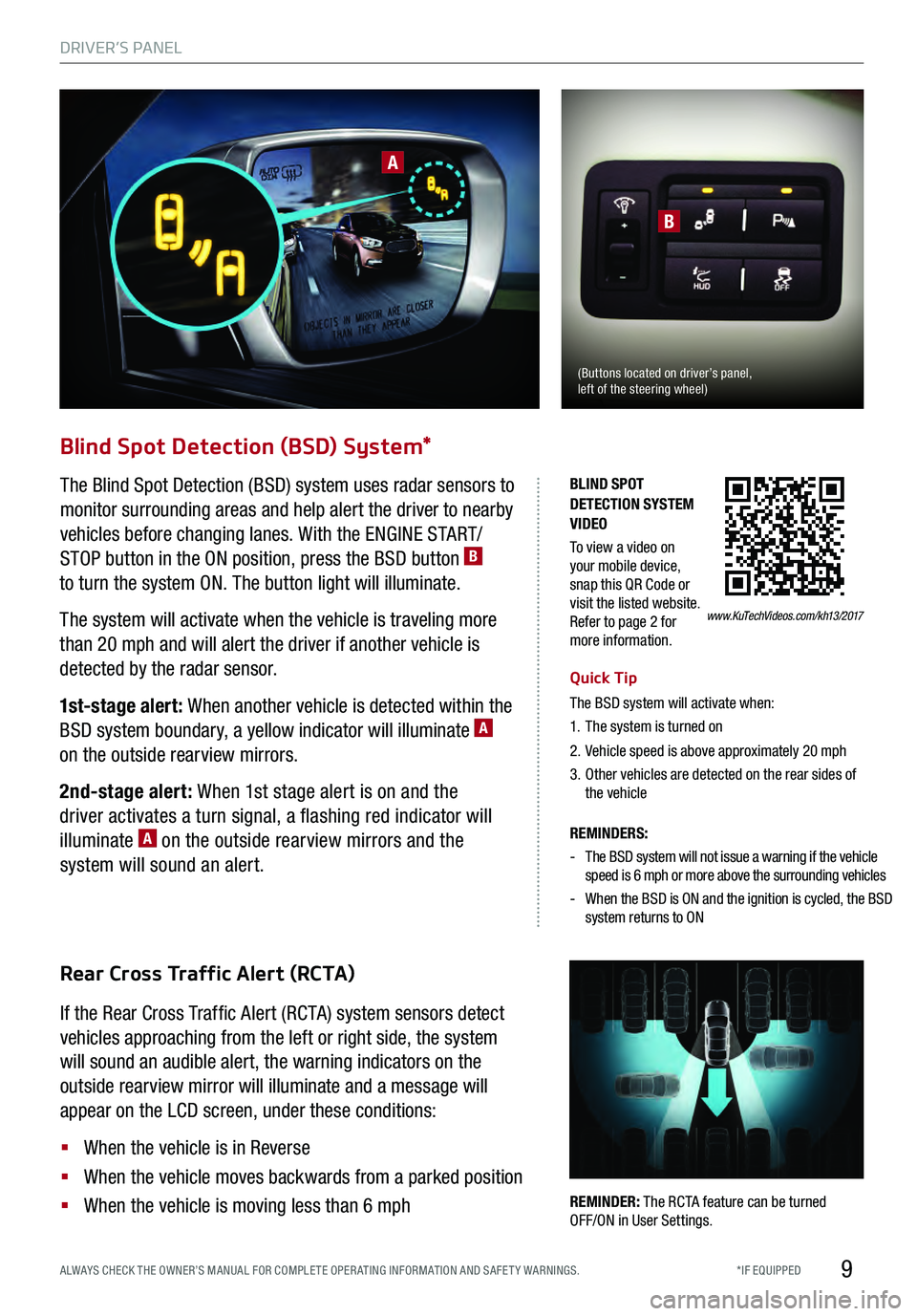
9
www.KuTechVideos.com/kh13/2017
BLIND SPOT
DETECTION SYSTEM
VIDEO
To view a video on
your mobile device,
snap this QR Code or
visit the listed website.
Refer to page 2 for
more information.
Blind Spot Detection (BSD) System*
The Blind Spot Detection (BSD) system uses radar sensors to
monitor surrounding areas and help alert the driver to nearby
vehicles before changing lanes. With the ENGINE START/
STOP button in the ON position, press the BSD button
B
to turn the system ON. The button light will illuminate.
The system will activate when the vehicle is traveling more
than 20 mph and will alert the driver if another vehicle is
detected by the radar sensor.
1st-stage alert: When another vehicle is detected within the
BSD system boundary, a yellow indicator will illuminate
A
on the outside rearview mirrors.
2nd-stage alert: When 1st stage alert is on and the
driver activates a turn signal, a flashing red indicator will
illuminate
A on the outside rearview mirrors and the
system will sound an alert.
Rear Cross Traffic Alert (RCTA)
If the Rear Cross Traffic Alert (RCTA) system sensors detect
vehicles approaching from the left or right side, the system
will sound an audible alert, the warning indicators on the
outside rearview mirror will illuminate and a message will
appear on the LCD screen, under these conditions:
§
When the vehicle is in Reverse
§
When the vehicle moves backwards from a parked position
§
When the vehicle is moving less than 6 mphREMINDER: The RCTA feature can be turned
OFF/ ON in User Settings .
A
B
Quick Tip
The BSD system will activate when:
1. The system is turned on
2. Vehicle speed is above approximately 20 mph
3. Other vehicles are detected on the rear sides of
the vehicle
REMINDERS:
- The BSD system will not issue a warning if the vehicle
speed is 6 mph or more above the surrounding vehicles
- When the BSD is ON and the ignition is cycled, the BSD
system returns to ON
(Buttons located on driver’s panel,
left of the steering wheel)
DRIVER’S PANEL
*IF EQUIPPED
ALWAYS CHECK THE OWNER’S MANUAL FOR COMPLE TE OPER ATING INFORMATION AND SAFE T Y WARNINGS.
Page 16 of 62

14
To start the engine:
1. Depress the brake pedal
2. Press the ENGINE START/STOP button while gear shift is
in P (Park)
To turn the engine OFF, press the ENGINE START/STOP
button while the gear shift is in P (Park).
To use the ENGINE START/STOP button, you must have the
Smart Key on your person or inside the vehicle.
Engine Start/Stop Button
www.KuTechVideos.com/kh13/2017
ENGINE STA RT/STOP
BUTTON AND
SMART KEY VIDEO
To view a video on
your mobile device,
snap this QR Code or
visit the listed website.
Refer to page 2 for
more information.
REMINDERS:
- If Smart Key fob battery is dead, you can still start the engine by pressing
the ENGINE START/STOP button with the Lock-button end of the Smart
Key. The Smart Key must contact the ENGINE START/STOP button directly,
at a right angle
- In an emergency situation while the vehicle is in motion, you are able to turn
the engine off and to the ACC position by pressing the ENGINE START/ STOP
button for more than 2 seconds or 3 times successively within 3 seconds
B
CA
Quick Tips
To use electrical accessories:
ACC position
- When in the OFF position A and without
depressing the brake pedal, press the ENGINE
START/STOP
button once. The ACC indicator will illuminate (amber) B.
To check warning light s:
ON position
- When already in the ACC position B and without
depressing the brake pedal, press the ENGINE
START/STOP button again. The ON indicator will
illuminate (red)
C.
- When in the OFF position A and without
depressing the brake pedal, press the ENGINE
START/STOP button twice. The ON indicator will
illuminate (red)
C.
Keeping the vehicle in ACC or ON position too long
can discharge the vehicle’s battery .
DRIVER’S PANEL
*IF EQUIPPED
DRIVER’S PANEL
*IF EQUIPPED
Page 29 of 62
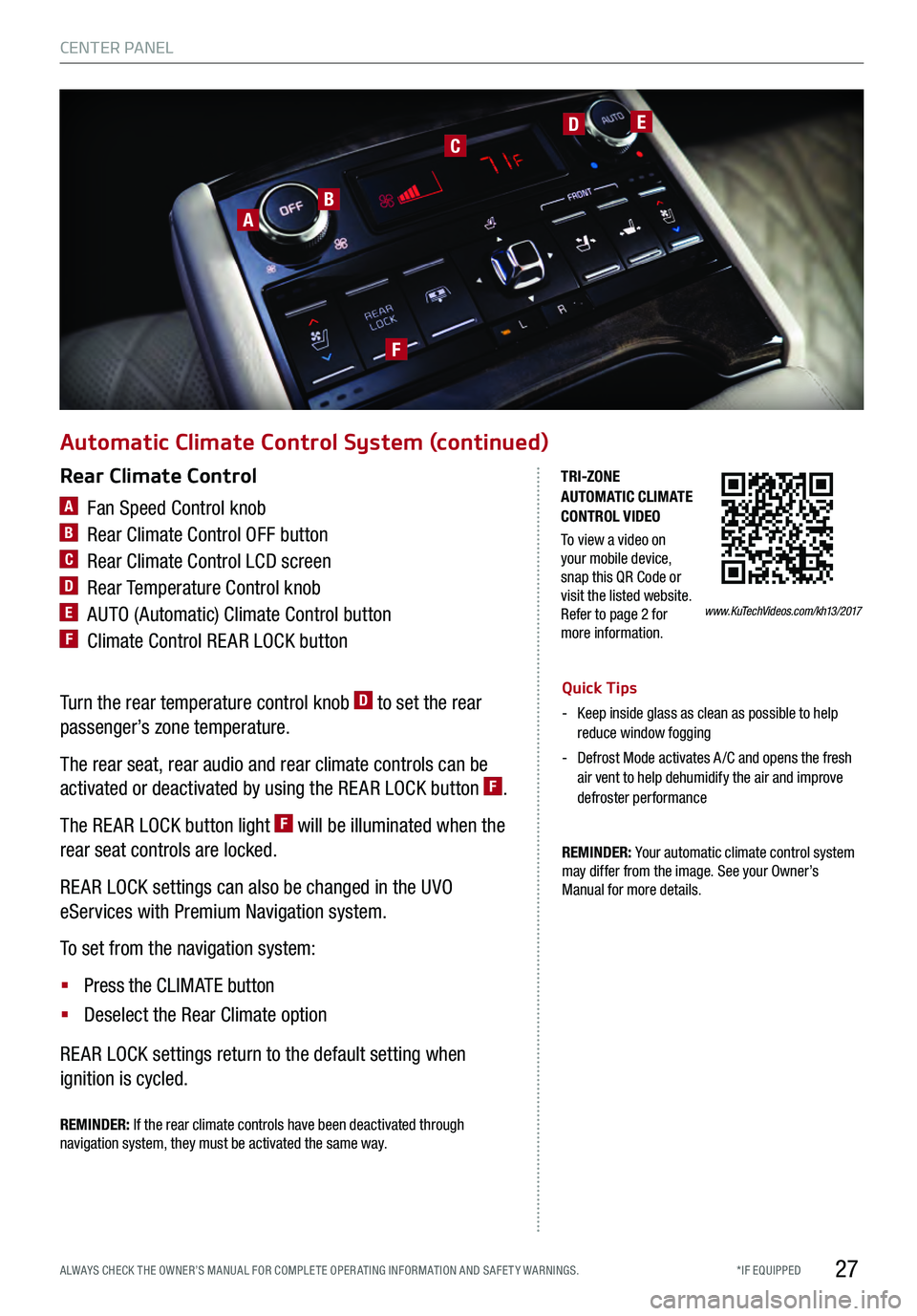
27
Automatic Climate Control System (continued)
REMINDER: Your automatic climate control system
may differ from the image. See your Owner’s
Manual for more details.
Quick Tips
- Keep inside glass as clean as possible to help reduce window fogging
- Defrost Mode activates A /C and opens the fresh air vent to help dehumidify the air and improve
defroster performance
Rear Climate Control
A Fan Speed Control knob
B Rear Climate Control OFF button
C Rear Climate Control LCD screen
D Rear Temperature Control knob
E AUTO (Automatic) Climate Control button
F Climate Control RE AR LOCK button
Turn the rear temperature control knob D to set the rear
passenger’s zone temperature.
The rear seat, rear audio and rear climate controls can be
activated or deactivated by using the RE AR LOCK button
F.
The RE AR LOCK button light
F will be illuminated when the
rear seat controls are locked.
RE AR LOCK settings can also be changed in the UVO
eServices with Premium Navigation system.
To set from the navigation system:
§
Press the CLIMATE button
§ Deselect the Rear Climate option
RE AR LOCK settings return to the default setting when
ignition is cycled.
AB
CDE
F
www.KuTechVideos.com/kh13/2017
TRI-ZONE
AUTOMATIC CLIMATE
CONTROL VIDEO
To view a video on
your mobile device,
snap this QR Code or
visit the listed website.
Refer to page 2 for
more information.
REMINDER: If the rear climate controls have been deactivated through
navigation system, they must be activated the same way.
CENTER PANEL
*IF EQUIPPED
ALWAYS CHECK THE OWNER’S MANUAL FOR COMPLE TE OPER ATING INFORMATION AND SAFE T Y WARNINGS.
Page 31 of 62

29
The Electric Parking Brake (EPB) system utilizes an electric
motor to engage the parking brake.
Applying the Parking Brake
Depress the brake pedal and pull up the EPB switch
C.
Ensure that the indicator light
is illuminated on the
instrument cluster.
Releasing the Parking Brake
The EPB will automatically release when the shifter is placed
in Reverse or Drive. To release EPB manually, depress the
brake pedal, then press the EPB switch
C, with the ignition
switch in the ON position. Ensure that the indicator light
i s O F F.
Electric Parking Brake (EPB)
Auto Hold
Quick Tip
Pull up and hold EPB switch again to increase brake
pressure if parked on a decline or incline.
www.KuTechVideos.com/kh13/2017
ELECTRIC PARKING
BRAKE (EPB) / AUTO
HOLD VIDEO
To view a video on
your mobile device,
snap this QR Code or
visit the listed website.
Refer to page 2 for
more information.
REMINDERS:
- As a bulb check, the EPB malfunction indicator will illuminate for approximately 3 seconds when the ignition switch is turned ON
- If the warning light does not illuminate temporarily or remains continuously lit, take your vehicle to an authorized Kia dealer and
have the system checked
- The EPB should not be operated while the vehicle is moving
- A click or electric brake motor sound may be heard while operating or releasing the EPB. These conditions are normal and indicate
that the EPB is functioning properly
Auto Hold temporarily maintains the vehicle at a standstill even if the brake pedal is released. Auto
Hold can be turned On/Off using the AUTO HOLD switch D on the center panel. Before Auto Hold
will operate, the driver’s door, engine hood and trunk must be closed and the driver’s seat belt must
be fastened.
The Auto Hold indicator, which is in the instrument cluster, has four states:
White : Standby – With vehicle at a standstill, and AUTO HOLD switch
D turned ON, the indicator
will illuminate white. While driving the vehicle (vehicle is not at a standstill), the Auto Hold indicator
will remain white.
Green : Engaged – When coming to a complete stop by depressing the brake pedal, the Auto Hold
indicator changes from white to green.
OFF (not illuminated) – The indicator will turn OFF when the AUTO HOLD switch
D is manually
turned OFF or when the EPB is manually turned ON.
Yellow : Malfunction – When the indicator is illuminated yellow, there may be a system malfunction.
Take your vehicle to a local Kia dealer.
CENTER PANEL
*IF EQUIPPED
ALWAYS CHECK THE OWNER’S MANUAL FOR COMPLE TE OPER ATING INFORMATION AND SAFE T Y WARNINGS.
Page 35 of 62

33
(Button located on center panel below the gear shift)
The rear and side window curtains offer passenger protection
from direct sunlight.
While the ENGINE START/STOP button is in the ACC/ON position,
press the power rear curtain button
A to raise/lower curtain.
REMINDER: Raising or lowering the rear curtain by hand may cause motor failure .
Power Rear Curtain
POWER REAR
CURTAIN & REAR
SIDE-WINDOW
CURTAINS VIDEO
To view a video on
your mobile device,
snap this QR Code or
visit the listed website.
Refer to page 2 for
more information.
Quick Tips
- The power rear curtain will lower automatically
when the gear shift is moved into the R (Reverse)
position and raise automatically when the gear
shift is moved from R (Reverse) into P (Park)
- When the gear shift is moved into D (Drive)
and the vehicle is traveling at speeds greater
t han 12 mph, the power rear curtain will unfold
automatically
A
(Button located on rear passenger’s control system)
A
www.KuTechVideos.com/kh13/2017
CENTER PANEL
*IF EQUIPPED
ALWAYS CHECK THE OWNER’S MANUAL FOR COMPLE TE OPER ATING INFORMATION AND SAFE T Y WARNINGS.
Page 37 of 62

35
Move/press controls to adjust headrest, seat forward/backward position, seat cushion length, seatback
angle or lumbar support.
Headrest Height Adjustment*: Move button
A up/down to adjust headrest height
Seatback Angle Adjustment: Move button
B forward/backward to adjust seatback angle
Seat Sliding, Seat Height and Cushion Length* Adjustments:
§
Move button C forward/backward to slide seat
§
Move front part of button D up/down to raise/lower front part of seat
§
Move back part of button E up/down to raise/lower back part of seat
§
Move button F forward/backward to increase/decrease cushion length*
Lumbar Support Adjustment:
§
Press G to increase support
§
Press H to decrease support
§
Press I to move lumbar support up/down
Power Adjustable Driver’s Seat
A
B
ED
F
C
GH
I
I
(Buttons located on left side of seat cushion)
(Controls located on door panel)
Power Height Adjustment* – To adjust the height, move
the seat control button A up/down.
Manual Tilt Adjustment – To adjust the headrest forward/
backward, tilt the lower part of the headrest at a slight angle.
Power Front Seat Headrest Adjustment*
S E AT I N G
*IF EQUIPPED
ALWAYS CHECK THE OWNER’S MANUAL FOR COMPLE TE OPER ATING INFORMATION AND SAFE T Y WARNINGS.